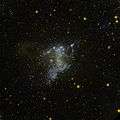NGC 6822
| NGC 6822 | |
|---|---|
 | |
| Observation data (J2000 epoch) | |
| Constellation | Sagittarius |
| Right ascension | 19h 44m 56.6s[1] |
| Declination | −14° 47′ 21″[1] |
| Redshift | -57 ± 2 km/s[1] |
| Distance | 1.63 ± 0.03 Mly (500 ± 10 kpc)[2][3][4] |
| Apparent magnitude (V) | 9.3[1] |
| Characteristics | |
| Type | IB(s)m[1] |
| Apparent size (V) | 15′.5 × 13′.5[1] |
| Other designations | |
|
Barnard's Galaxy,[1] IC 4895,[1] DDO 209,[1] PGC 63616,[1] Caldwell 57 | |
NGC 6822 (also known as Barnard's Galaxy, IC 4895, or Caldwell 57) is a barred irregular galaxy approximately 1.6 million light-years away in the constellation Sagittarius. Part of the Local Group of galaxies, it was discovered by E. E. Barnard in 1884 (hence its name), with a six-inch refractor telescope. It is one of the closer galaxies to the Milky Way. It is similar in structure and composition to the Small Magellanic Cloud. It is about 7,000 light-years in diameter.[5]
Observational history
Edwin Hubble, in the paper N.G.C. 6822, A Remote Stellar System,[6] identified 15 variable stars (11 of which were Cepheids) of this galaxy. He also surveyed the galaxy's stars distribution down to magnitude 19.4. He provided spectral characteristics, luminosities and dimensions for the five brightest "diffuse nebulae" (giant H II regions) that included the Bubble Nebula and the Ring Nebula. He also computed the absolute magnitude of the entire galaxy.
Hubble's detection of eleven Cepheid variable stars was a milestone in astronomy. Utilizing the Cepheid Period-Luminosity relationship, Hubble determined a distance of more than 700,000 light-years. This was the first system beyond the Magellanic Clouds to have its distance accurately determined. (Hubble continued this process with the Andromeda Galaxy and the Triangulum Galaxy). His distance to the galaxy was way beyond Harlow Shapley's value of 300,000 light-years for the size of universe. In the paper, Hubble concluded the "Great Debate" of 1920 between Heber Curtis and Shapley over the scale of the universe and the nature of the "spiral nebula". It soon became evident that all spiral nebulae were in fact spiral galaxies far outside our own Milky Way.
An analysis of Hubble's plates by Susan Kayser in 1966 remained the most complete study of this galaxy until 2002.[7]
In 1977, Paul W. Hodge extended the list of known H II regions in Barnard to 16. Today, there are over 150 of these regions catalogued in Barnard's Galaxy.
Gallery
 NGC 6822 in ultraviolet by GALEX.
NGC 6822 in ultraviolet by GALEX..jpg) "Star-Forming Region" in NGC 6822.
"Star-Forming Region" in NGC 6822. "A Giant Star Factory" in NGC 6822.
"A Giant Star Factory" in NGC 6822. NGC 6822 from ESO's Wide Field Imager.
NGC 6822 from ESO's Wide Field Imager.
See also
| Wikimedia Commons has media related to NGC 6822. |
- Bubble Nebula (NGC 6822)
- Ring Nebula (NGC 6822)
- Large Magellanic Cloud - another irregular galaxy within the Local Group
- Small Magellanic Cloud - another irregular galaxy within the Local Group
Notes
- 1 2 3 4 5 6 7 8 9 10 "NASA/IPAC Extragalactic Database", Results for NGC 6822, retrieved 2007-03-15
- ↑ Karachentsev et al. 2004
- ↑ Karachentsev & Kashibadze 2006
- ↑ Cannon et al. 2006
- ↑ NGC 6822: Barnard's Galaxy APOD , NASA , 8 February 2013
- ↑ (Hubble 1925)
- ↑ https://www.noao.edu/outreach/press/pr02/pr0202.html
Sources
- Cannon, John M.; Walter, Fabian; Armus, Lee; Bendo, George J.; Calzetti, Daniela; Draine, Bruce T.; Engelbracht, Charles W.; Helou, George; et al. (December 2006), "The Nature of Infrared Emission in the Local Group Dwarf Galaxy NGC 6822 as Revealed by Spitzer", The Astrophysical Journal, 652 (2), pp. 1170–1187, arXiv:astro-ph/0608249
 , Bibcode:2006ApJ...652.1170C, doi:10.1086/508341
, Bibcode:2006ApJ...652.1170C, doi:10.1086/508341 - Hubble, Edwin P. (December 1925), "NGC 6822, a remote stellar system", Astrophysical Journal, 62, pp. 409–433, Bibcode:1925ApJ....62..409H, doi:10.1086/142943
- Karachentsev, I. D.; Karachentseva, V. E.; Hutchmeier, W. K.; Makarov, D. I. (April 2004), "A Catalog of Neighboring Galaxies", Astronomical Journal, 127 (4), pp. 2031–2068, Bibcode:2004AJ....127.2031K, doi:10.1086/382905
- Karachentsev, I. D.; Kashibadze, O. G. (January 2006), "Masses of the local group and of the M81 group estimated from distortions in the local velocity field", Astrophysics, 49 (1), pp. 3–18, Bibcode:2006Ap.....49....3K, doi:10.1007/s10511-006-0002-6
- Robert Burnham, Jr, Burnham's Celestial Handbook: An obsever's guide to the universe beyond the solar system, vol 3, p.1559
External links
- The Milky Way's Tiny but Tough Galactic Neighbour — ESO Press Release
- NGC 6822: Barnard's Galaxy
- NGC 6822 on WikiSky: DSS2, SDSS, GALEX, IRAS, Hydrogen α, X-Ray, Astrophoto, Sky Map, Articles and images
Coordinates: ![]() 19h 44m 56.6s, −14° 47′ 21″
19h 44m 56.6s, −14° 47′ 21″